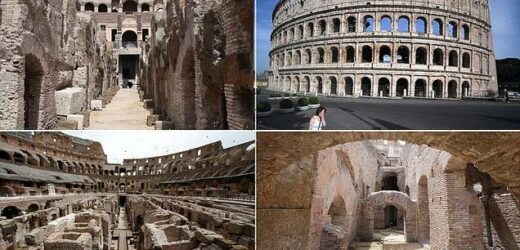Rome’s Colosseum opens passageways under the arena floor to the public for the first time, allowing visitors to stroll through dungeons that held doomed prisoners, lions and gladiators
- The substructure of the Colosseum, or hypogeum, has been restored and is now open to tourists
- This part of the monument consists of passageways and tunnels that once sat under the main floor
- This area was constructed with dungeons that held prisoners, along with cages for exotic animals
- Gladiators also waited in the hypogeum prior to fighting on the main floor in front of up to 50,000 people
- The restoration of the passageways was a $30 million project that took two years to complete
Rome’s 2,000-year-old Colosseum is the ‘beating heart’ of the Italian city that attracts about six million tourists each year, but for the first time visitors can walk through its underground passages due to the completion of a $30 million restoration project.
More than 80 archaeologists, architects and engineers worked on the ‘hypogeum,’ the substructure, for two years to ‘bring back to the center of the attention a monument that the whole world loves’, Diego della Valle, chairman of Tod´s, the Italian fashion group that funded the work, told Reuters in an interview.
This is the first time the 525 feet walkway will be accessible to the public, which also reveals part of the stone amphitheater that was previously blocked to tourists.
These walkways once held cages and rooms where prisoners, animals and gladiators waited to pass through trapdoors to enter the arena above their heads, where they fought to the death in front of bloodthirsty spectators.
Scroll down for video
Rome’s 2,000-year-old Colosseum is the ‘beating heart’ of the Italian city that attracts about six million tourist each year, but for the first time visitors can walk through its underground passages
The ancient passages are the second phase of a three-stage process to restore the Colosseum, all of which began eight years ago.
Tod’s pledged $30 million to the project, with the hopes of returning the one of the Seven Wonders of the Modern World back to its original glory.
‘This is about important pieces for Italy, monuments that are well-known all over the world, and tourism, which is not only entertainment but an important business in Italy which, if cared for properly, has no rival anywhere in the world,’ Della Valle said.
The substructure includes a system of tunnels with two main corridors, all of which was laid out like a labyrinth.
The construction of the Colosseum began under empire of Vespasian in year 72, and was completed eight years later when Emperor Titus ruled the Roman Empire
These walkways once held cages and rooms where prisoners, animals and gladiators waited to pass through trapdoors to enter the arena above their heads
More than 80 archaeologists, architects and engineers worked on the ‘hypogeum,’ the substructure, for two years to ‘bring back to the center of the attention a monument that the whole world loves
The tunnels also lead to other buildings outside of the Colosseum.
There were a total of 36 trap doors throughout the arena, which provided special effects for spectators.
Elevators and pulleys were connected to the trap doors, allowing gladiators, stage props and animals to ‘magically appear’ on the main floor.
Rooms were built with windows to allow air circulation for slaves who were tasked with feeding the wild animals kept in cages.
The hypogeum had laid buried 40 feet under the ground until the 19th century, but it was not fully exposed until Benito Mussolini declared a glorification of classical Rome while he ruled Italy.
The first phase of the Colosseum restoration project, including a cleanup of the façade, was unveiled in 2016.
The substructure includes a system of tunnels with two main corridors, all of which was laid out like a labyrinth. The tunnels also lead to other buildings outside of the Colosseum.
Elevators and pulleys were connected to the trap doors, allowing gladiators, stage props to ‘magically appear’ on the main floor. Rooms were built with windows to allow air circulation for slaves who were tasked with feeding the wild animals kept in cages
The hypogeum had laid buried 40 feet under the ground until the 19th century, but it was not fully exposed until Benito Mussolini declared a glorification of classical Rome in the mid-1900s
This is the first time the 525 feet walkway will be accessible to the public, which also reveals part of the stone amphitheater that was previously blocked to tourists
The final phase involves renewing the galleries and the lighting system and creating a new visitor center, which is set to be completed in about three years.
Della Valle, who also helps fund Milan’s La Scala opera house, called on fellow entrepreneurs to ‘take a monument each, restore it, let´s be quick!’.
The floor of the Colosseum is also under construction to be restored, which will give visitors a gladiator’s eye view of the ancient amphitheater’s ‘majesty’.
Italian culture minister Dario Franceschini announced a $22 million contract in March 2021 to restore the arena floor, allowing visitors to walk in the center of the monument and stand in the same place as fighters did thousands of years ago.
Milan Ingengneria, an engineering firm, won the contract and plans to design a high-tech, retractable wooden floor that is set to be completed by 2023.
To celebrate the completing of the Colosseum, Emperor Titus held 100 days of games that saw more than 2,000 gladiators die in the arena
The Colosseum accommodated more than 50,000 people, who flocked to the arena to see exotic animals, prisoner executions and gladiator fights
The Colosseum was used for more than 500 years, with its last recorded games held in the 6th century
The new floor will have wooden slats connected to rails, allowing it to rotate 90 degrees so it can be pulled together to reveal the newly restore passage ways.
The construction of the Colosseum began under empire of Vespasianin 72 AD, and was completed eight years later when Emperor Titus ruled the Roman Empire, according to Rome.net.
To celebrate the completing of the gigantic stone structure, Titus held 100 days of games that saw more than 2,000 gladiators die in the arena.
It accommodated more than 50,000 people, who flocked to the arena to see exotic animals, prisoner executions and gladiator fights.
The Colosseum was used for more than 500 years, with its last recorded games held in the 6th century.
Source: Read Full Article













